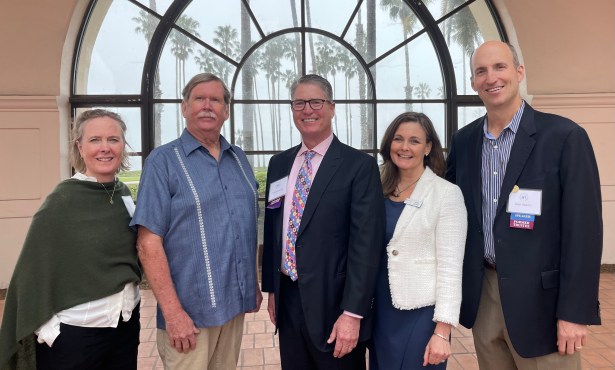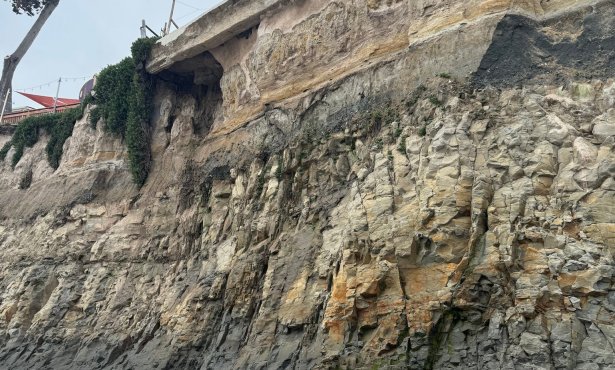Q: ‘What is the story behind the Hollister of Hollister Avenue?’
Q: ‘What is the story behind the Hollister of Hollister Avenue?’
—Deanna Gregg
by Michael Redmon
William Welles Hollister was born into an Ohio farm family in
1818. After his father’s death, he and his brothers ran the family
farm, iron foundry, and mercantile store until 1852, when W.W.
joined a wagon train headed for California.
Hollister traveled up and down the state, spending some time in
the colorfully named town of Volcano in the gold country. He
returned east and convinced his brother Joseph to join him in
California. With their sister Lucy they drove a flock of 4,000
sheep westward. It was a difficult trek. The party had to fight off
Piute Indian attacks and the brothers had to face down a mutiny of
hired hands when the latter initially refused to carry the sheep
one by one across a swift-running river. Additional hazards
included drought and blizzards. The Hollisters lost well over half
their animals on the 15-month trip, but still deemed it a
success.
The Hollisters and their various partners, most notably Albert
and Thomas Dibblee, became highly successful ranchers, buying more
than 140,000 acres all across the state; this included ranches in
Lompoc, Gaviota, and other areas in Santa Barbara County. Their
county holdings stood at more than 125,000 acres. In 1869,
Hollister bought property in Tecolote Canyon in Goleta, and named
his new ranch Glen Annie, after his wife, Annie James. He made the
ranch an agricultural showcase, raising crops not normally
associated with this area, including coffee, bananas, tea, and
dates.
Hollister became one of the most prominent citizens of Santa
Barbara. He was a key stockholder in such civic improvements as
Stearns Wharf, the San Marcos Building, and the Lobero Theatre. For
a short period the San Marcos Building housed Santa Barbara
College, an institution providing elementary and high school-level
education, which Hollister co-founded. Hollister owned the
Arlington Hotel for a time, Santa Barbara’s first luxury hostelry.
Its opening in 1875 was a watershed event in the development of
tourism here. Hollister was also a prime mover in setting up the
city’s first public library as well as bankrolling the Santa
Barbara Press, the voice of the Republican Party in the city. In
1872, his financial support allowed José Lobero’s dream of building
an opera house in Santa Barbara to become a reality. In 1875, he
built his Grand Avenue from Glen Annie to town, now known as
Hollister Avenue.
Hollister’s purchase of his beloved Glen Annie ended in
heartache for his family. Hollister had purchased the ranch from
the heirs of Nicholas Den, despite receiving some pointed advice
that title to the ranch was clouded at best. In 1876, the heirs’
attorney, Thomas B. Bishop of San Francisco, filed suit to void the
sale. After 14 years of legal wrangling, four years after
Hollister’s death, Annie Hollister was ordered by the court to
vacate the premises. As Annie left her home in upper Glen Annie
Canyon for the last time, the house mysteriously burst into flames
and burned to the ground, the cause never officially explained.
Bishop took as his legal fee the lower portion of the ranch, which
became popularly known as the Bishop Ranch.
By the early 1880s, Hollister’s health was failing, due in part
to his accidentally ingesting gopher poison. He moved to the San
Marcos Building, now a hotel, to be closer to his private
physician, Dr. Robert Winchester (of Winchester Canyon). Hollister
died at the hotel in 1886. He was laid to rest in Santa Barbara
Cemetery. The funeral cortège stretched some three miles from the
Arlington to the cemetery, a fitting farewell to one of Santa
Barbara’s outstanding citizens.
Michael Redmon, director of research at the Santa Barbara
Historical Society, will answer your questions about Santa
Barbara’s history. Write him c/o The Independent, 122 W. Figueroa
St., Santa Barbara, CA 93101.



